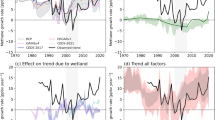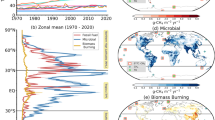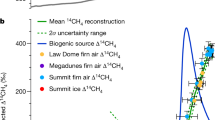Abstract
Methane has the second-largest global radiative forcing impact of anthropogenic greenhouse gases after carbon dioxide, but our understanding of the global atmospheric methane budget is incomplete. The global fossil fuel industry (production and usage of natural gas, oil and coal) is thought to contribute 15 to 22 per cent of methane emissions1,2,3,4,5,6,7,8,9,10 to the total atmospheric methane budget11. However, questions remain regarding methane emission trends as a result of fossil fuel industrial activity and the contribution to total methane emissions of sources from the fossil fuel industry and from natural geological seepage12,13, which are often co-located. Here we re-evaluate the global methane budget and the contribution of the fossil fuel industry to methane emissions based on long-term global methane and methane carbon isotope records. We compile the largest isotopic methane source signature database so far, including fossil fuel, microbial and biomass-burning methane emission sources. We find that total fossil fuel methane emissions (fossil fuel industry plus natural geological seepage) are not increasing over time, but are 60 to 110 per cent greater than current estimates1,2,3,4,5,6,7,8,9,10 owing to large revisions in isotope source signatures. We show that this is consistent with the observed global latitudinal methane gradient. After accounting for natural geological methane seepage12,13, we find that methane emissions from natural gas, oil and coal production and their usage are 20 to 60 per cent greater than inventories1,2. Our findings imply a greater potential for the fossil fuel industry to mitigate anthropogenic climate forcing, but we also find that methane emissions from natural gas as a fraction of production have declined from approximately 8 per cent to approximately 2 per cent over the past three decades.
This is a preview of subscription content, access via your institution
Access options
Subscribe to this journal
Receive 51 print issues and online access
$199.00 per year
only $3.90 per issue
Buy this article
- Purchase on Springer Link
- Instant access to full article PDF
Prices may be subject to local taxes which are calculated during checkout



Similar content being viewed by others
References
US Environmental Protection Agency. Summary Report: Global Anthropogenic Non-CO2 Greenhouse Gas Emissions: 1990–2030 https://www3.epa.gov/climatechange/Downloads/EPAactivities/Summary_Global_NonCO2_Projections_Dec2012.pdf (Office of Atmospheric Programs, Climate Change Division, US EPA, 2012)
European Commission—Joint Research Centre (JRC)/Netherlands Environmental Assessment Agency (PBL). Emission Database for Global Atmospheric Research (EDGAR), release version 4.2, http://edgar.jrc.ec.europa.eu (2014)
Bousquet, P. et al. Contribution of anthropogenic and natural sources to atmospheric methane variability. Nature 443, 439–443 (2006)
Mikaloff Fletcher, S. E., Tans, P. P., Bruhwiler, L. M., Miller, J. B. & Heimann, M. CH4 sources estimated from atmospheric observations of CH4 and its 13C/12C isotopic ratios: 1. Inverse modeling of source processes. Glob. Biogeochem. Cycles 18, GB4004 (2004)
Fraser, A. et al. Estimating regional methane surface fluxes: the relative importance of surface and GOSAT mole fraction measurements. Atmos. Chem. Phys. 13, 5697–5713 (2013)
Wang, J. S. et al. A 3-D model analysis of the slowdown and interannual variability in the methane growth rate from 1988 to 1997. Glob. Biogeochem. Cycles 18, GB3011 (2004)
Chen, Y.-H. & Prinn, R. G. Estimation of atmospheric methane emissions between 1996 and 2001 using a three-dimensional global chemical transport model. J. Geophys. Res. Atmos. 111, D10307 (2006)
Bergamaschi, P. et al. Inverse modeling of global and regional CH4 emissions using SCIAMACHY satellite retrievals. J. Geophys. Res. 114, D22301 (2009)
Schwietzke, S., Griffin, W. M., Matthews, H. S. & Bruhwiler, L. M. P. Natural gas fugitive emissions rates constrained by global atmospheric methane and ethane. Environ. Sci. Technol. 48, 7714–7722 (2014)
Quay, P. et al. The isotopic composition of atmospheric methane. Glob. Biogeochem. Cycles 13, 445–461 (1999)
Kirschke, S. et al. Three decades of global methane sources and sinks. Nat. Geosci. 6, 813–823 (2013)
Etiope, G., Lassey, K. R., Klusman, R. W. & Boschi, E. Reappraisal of the fossil methane budget and related emission from geologic sources. Geophys. Res. Lett. 35, L09307 (2008)
Ciais, P. et al. in Working Group I Contribution To The IPCC Fifth Assessment Report. Climate Change 2013—The Physical Science Basis (eds Stocker, T. F. et al..) Ch. 6, 465–570 (Cambridge Univ. Press, 2013)
Sherwood, O., Schwietzke, S., Arling, V. & Etiope, G. Global Inventory of Fossil and Non-fossil Methane δ13C Source Signature Measurements for Improved Atmospheric Modeling http://www.esrl.noaa.gov/gmd/ccgg/d13C-src-inv/ (NOAA/ESRL/GMD, 2016)
Alvarez, R. A., Pacala, S. W., Winebrake, J. J., Chameides, W. L. & Hamburg, S. P. Greater focus needed on methane leakage from natural gas infrastructure. Proc. Natl Acad. Sci. USA 109, 6435–6440 (2012)
US Energy Information Administration International Energy Statistics database http://www.eia.gov/cfapps/ipdbproject/IEDIndex3.cfm?tid=3&pid=3&aid=1 (2016)
Whiticar, M. J. in Organic Geochemistry (eds Durand, B. & Behar, F. ) Vol. 16, 531–548 (Pergamon, 1990)
Milkov, A. V. Worldwide distribution and significance of secondary microbial methane formed during petroleum biodegradation in conventional reservoirs. Org. Geochem. 42, 184–207 (2011)
Meslé, M., Dromart, G. & Oger, P. Microbial methanogenesis in subsurface oil and coal. Res. Microbiol. 164, 959–972 (2013)
NOAA Earth System Research Laboratory Global Monitoring Division Global Greenhouse Gas Reference Networkhttp://www.esrl.noaa.gov/gmd/ccgg/iadv (2016)
Schaefer, H. et al. A 21st century shift from fossil-fuel to biogenic methane emissions indicated by 13CH4 . Science 352, 80–84 (2016)
US Environmental Protection Agency. Inventory of U.S. Greenhouse Gas Emissions and Sinks: 1990–2014https://www.epa.gov/ghgemissions/us-greenhouse-gas-inventory-report-1990-2014 (2016)
Randerson, J. T., Chen, Y., van der Werf, G. R., Rogers, B. M. & Morton, D. C. Global burned area and biomass burning emissions from small fires. J. Geophys. Res. 117, G04012 (2012)
Sapart, C. J. et al. Natural and anthropogenic variations in methane sources during the past two millennia. Nature 490, 85–88 (2012)
Mischler, J. A. et al. Carbon and hydrogen isotopic composition of methane over the last 1000 years. Glob. Biogeochem. Cycles 23, GB4024 (2009)
Sowers, T. Atmospheric methane isotope records covering the Holocene period. Quat. Sci. Rev. 29, 213–221 (2010)
Krol, M. et al. The two-way nested global chemistry-transport zoom model TM5: algorithm and applications. Atmos. Chem. Phys. 5, 417–432 (2005)
Schwietzke, S., Griffin, W. M., Matthews, H. S. & Bruhwiler, L. M. P. Global bottom-up fossil fuel fugitive methane and ethane emissions inventory for atmospheric modeling. ACS Sustain. Chem. Eng. 2, 1992–2001 (2014)
International Energy Agency Coal Mine Methane in China: A Budding Asset with the Potential to Bloomhttps://www.iea.org/publications/freepublications/publication/china_cmm_report.pdf (2009)
Lassey, K. R., Lowe, D. C. & Smith, A. M. The atmospheric cycling of radiomethane and the ‘fossil fraction’ of the methane source. Atmos. Chem. Phys. 7, 2141–2149 (2007)
Acknowledgements
We thank J. Randerson, K. Johnson, A. Cole, C. Itle, T. Wirth, T. Capehart, S. Montzka, and R. Klusman for comments and discussions. We acknowledge M. Schoell and A. Ionescu for contributing δ13Csource data. This research was supported by a National Research Council RAP fellowship and a CIRES IRP grant.
Author information
Authors and Affiliations
Contributions
S.S. was responsible for study design, box-model development, analysis of TM5 results, manuscript preparation, and helped provide data. P.P.T. and J.B.M. helped with study design and improved the manuscript. O.A.S., G.E., E.J.D., S.E.M., V.A.A., B.H.V. and J.W.C.W. provided data and improved the manuscript. L.M.P.B. was responsible for TM5 modelling, helped with model analysis, and improved the manuscript.
Corresponding author
Ethics declarations
Competing interests
The authors declare no competing financial interests.
Additional information
Supplementary information
Supplementary Information
This file contains a list of acronyms, the box-model descriptions, atmospheric measurements used, isotopic signature database details (data, explanations, and weighting schemes, paleo CH4 budget analysis, global latitudinal CH4 gradient simulations (TM5 model), and all sensitivity analyses. (PDF 2893 kb)
Rights and permissions
About this article
Cite this article
Schwietzke, S., Sherwood, O., Bruhwiler, L. et al. Upward revision of global fossil fuel methane emissions based on isotope database. Nature 538, 88–91 (2016). https://doi.org/10.1038/nature19797
Received:
Accepted:
Published:
Issue Date:
DOI: https://doi.org/10.1038/nature19797
This article is cited by
-
National quantifications of methane emissions from fuel exploitation using high resolution inversions of satellite observations
Nature Communications (2023)
-
Widespread natural methane and oil leakage from sub-marine Arctic reservoirs
Nature Communications (2023)
-
Untangling variations in the global methane budget
Communications Earth & Environment (2023)
-
Nitrate-Dependent Anaerobic Methane Oxidation in Subtropical Mangrove Soils and Environmental Implication
Wetlands (2023)
-
Improved global wetland carbon isotopic signatures support post-2006 microbial methane emission increase
Communications Earth & Environment (2022)
Comments
By submitting a comment you agree to abide by our Terms and Community Guidelines. If you find something abusive or that does not comply with our terms or guidelines please flag it as inappropriate.



